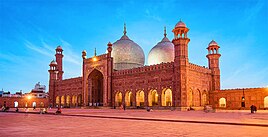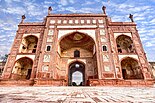
Back Lahore Afrikaans ለሖር Amharic لاهور Arabic لاهور ARZ Lahore AST लाहौर AWA Lahor Azerbaijani لاهور AZB Лахор Bashkir Lahore BAN
Lahore (/ləˈhɔːr/ lə-HOR; Punjabi: لہور [lɔː˩˥ɾ]; Urdu: لاہور [laːˈɦɔːɾ] ⓘ) is the capital and largest city of the Pakistani province of Punjab. It is the second largest city in Pakistan, after Karachi, and 27th largest in the world, with a population of over 14 million.[17] Lahore is one of Pakistan's major industrial, educational and economic hubs.[12][13] It has been the historic capital and cultural center of the wider Punjab region,[18][19][20] and is one of Pakistan's most socially liberal,[21] progressive,[22] and cosmopolitan cities.[23]
Lahore's origin dates back to antiquity. The city has been inhabited for around two millennia, although it rose to prominence in the late 10th century with the establishment of the Walled City, its fortified interior.[24] Lahore served as the capital of several empires during the medieval era, including the Hindu Shahis, Ghaznavid Empire and Delhi Sultanate. It reached the height of its splendor under the Mughal Empire between the late 16th and early 18th centuries, being its capital city for many years. During this period, it was one of the largest cities in the world.[25] The city was captured by the forces of the Afsharid ruler Nader Shah in 1739. Although the Mughal authority was re-established, it fell into a period of decay while being contested among the Afghans and the Sikhs between 1748 and 1798. Lahore eventually became the capital of the Sikh Empire in the early 19th century, regaining some of its lost grandeur.[26] Lahore was annexed to the British Raj in 1849 and became the capital of British Punjab.[27] Lahore was central to the independence movements of both India and Pakistan, with the city being the site of both the Declaration of Indian Independence and the resolution calling for the establishment of Pakistan. It experienced some of the worst rioting during the Partition period preceding Pakistan's independence.[28] Following the success of the Pakistan Movement and the subsequent partition of British India in 1947, Lahore was declared the capital of Pakistan's Punjab province.
Located in central-eastern Punjab, along the River Ravi, it is the largest Punjabi-speaking city in the world. Lahore exerts a strong cultural and political influence over Pakistan.[29] A UNESCO City of Literature and major centre for Pakistan's publishing industry, Lahore remains the foremost center of Pakistan's literary scene. The city is also a major centre of education sector,[30] with some of Pakistan's leading universities based in the city.[31] Lahore is home to Pakistan's Punjabi film industry, and is a major centre of Qawwali music.[32] The city also hosts much of Pakistan's tourist industry,[32][33] with major attractions including the Walled City, the famous Badshahi and Wazir Khan mosques, as well as several Sikh and Sufi shrines. Lahore is also home to the Lahore Fort and Shalimar Gardens, both of which are UNESCO World Heritage Sites.[33]
- ^ "Landing in the heart of Pakistan". The Express Tribune. 9 August 2015. Archived from the original on 23 April 2021. Retrieved 22 April 2021.
- ^ Smith, Oliver (12 June 2018). "Paris of the East? Athens of the North? The cities with ideas above their station". The Telegraph. Archived from the original on 10 January 2022 – via www.telegraph.co.uk.
- ^ "The 'City of Lights' vs 'City of Gardens'". 12 January 2018. Archived from the original on 14 June 2021. Retrieved 23 September 2020.
- ^ Shoaib Ahmed (4 February 2021). "Unesco confers 'City of Literature' title on Lahore". Dawn. Archived from the original on 31 August 2021. Retrieved 31 August 2021.
- ^ "Local govts term ends today". Dawn. 31 December 2021. Archived from the original on 5 January 2022. Retrieved 5 January 2022.
- ^ "Anti-encroachment Drive To Start On 20th". UrduPoint. 19 December 2023. Retrieved 19 December 2023.
- ^ "Punjab Portal". Government of Punjab. Archived from the original on 25 June 2014. Retrieved 7 July 2014.
- ^ a b "Lahore topographic map, elevation, terrain". Topographic maps. Retrieved 1 May 2024.
- ^ "Announcement of Results of 7th Population and Housing Census-2023 (Punjab province)" (PDF). Pakistan Bureau of Statistics. 5 August 2023. Retrieved 24 November 2023.
- ^ "A Lahori for life". The News International (newspaper). 12 December 2021. Archived from the original on 6 January 2022. Retrieved 6 January 2022.
- ^ "National Dialing Codes". Pakistan Telecommunication Company Limited. Archived from the original on 3 September 2014. Retrieved 28 August 2014.
- ^ a b "Pakistan: 4 Top Cities". The Business Year. 16 October 2020. Archived from the original on 20 November 2021. Retrieved 25 November 2021.
- ^ a b "[Home page]". www.finance.gov.pk. Finance Division | Government of Pakistan. Archived from the original on 6 March 2023. Retrieved 6 March 2023.
- ^ "Inclusive growth and human development". UNDP. Retrieved 7 November 2024.
- ^ "LAHORE: The patron saint of Lahore". DAWN.COM. 11 April 2004. Retrieved 17 November 2024.
- ^ "Hazrat Data Gunj Bukhsh (RA), Lahore". Auqaf and Religious Affairs Department.
- ^ "Lahore, Pakistan Metro Area Population 1950-2024". www.macrotrends.net. Retrieved 23 December 2024.
- ^ "History". 22 April 2008. Archived from the original on 29 December 2008. Retrieved 16 September 2011.
- ^ Shelley, Fred (16 December 2014). The World's Population: An Encyclopedia of Critical Issues, Crises, and Ever-Growing Countries. ABC-CLIO. p. 356. ISBN 978-1-61069-506-0.
Lahore is the historic center of the Punjab region of the northwestern portion of the Indian subcontinent
- ^ Usha Masson Luther (1990). Historical Routes of North West Indian Subcontinent, Lahore to Delhi, 1550s–1850s A.D.: Network Analysis Through DCNC-micro Methodology. Sagar Publications.
- ^ Diminishing Conflicts in Asia and the Pacific: Why Some Subside and Others Don't. Routledge. 2013. ISBN 978-0-415-67031-9. Retrieved 8 April 2017.
Lahore, perhaps Pakistan's most liberal city...
- ^ Craig, Tim (9 May 2015). "The Taliban once ruled Pakistan's Swat Valley. Now peace has returned". The Washington Post. ISSN 0190-8286. Archived from the original on 24 January 2022. Retrieved 11 February 2018.
"We now want to dress like the people of Punjab," said Abid Ibrahim, 19, referring to the eastern province that includes Lahore, often referred to as Pakistan's most progressive city.
- ^ "Lahore attack: Pakistan PM Sharif demands swift action on terror". BBC. 28 March 2016. Archived from the original on 16 December 2021. Retrieved 19 August 2016.
Lahore is one of Pakistan's most liberal and wealthy cities. It is Mr Sharif's political powerbase and has seen relatively few terror attacks in recent years.
- ^ Majid Sheikh (22 August 2004). "The 'shroud' over Lahore's antiquity". Dawn. Archived from the original on 6 March 2023. Retrieved 6 March 2023.
- ^ Dyson, Tim (2018). A Population History of India: From the First Modern People to the Present Day. Oxford University Press. ISBN 978-0-19-882905-8. Archived from the original on 4 April 2023. Retrieved 16 March 2023.
- ^ Glover (2008), p. [page needed].
- ^ "Rising Lahore and reviving Pakistan". The Express Tribune. 21 July 2013. Archived from the original on 10 May 2021. Retrieved 16 June 2016.
- ^ Kudaisya & Yong (2004), p. [page needed].
- ^ Discover Lahore: The Heart of Pakistan[permanent dead link] Chicago Sister Cities International
- ^ Shoaib Ahmed (4 March 2005). "Lahore book fair opens to rave reviews". Daily Times. Archived from the original on 12 February 2008. Retrieved 16 September 2011.
- ^ S. Akbar Zaidi (15 October 2012). "Lahore's domination". Dawn. Pakistan. Archived from the original on 20 November 2021. Retrieved 16 June 2016.
- ^ a b Windsor, Antonia (22 November 2006). "Out of the rubble". The Guardian. London. Archived from the original on 5 November 2013. Retrieved 27 March 2010.
- ^ a b "Lahore, Pakistan". Lonely Planet. Archived from the original on 20 November 2021. Retrieved 16 June 2016.
Cite error: There are <ref group=lower-alpha> tags or {{efn}} templates on this page, but the references will not show without a {{reflist|group=lower-alpha}} template or {{notelist}} template (see the help page).












